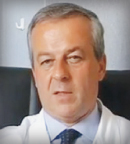Monotherapy with blinatumomab as consolidation therapy before allogeneic stem cell transplant appears to be the optimal treatment for children with high-risk first-relapse B-cell precursor acute lymphoblastic leukemia (ALL), according to an international phase III trial that compared this approach with high-risk consolidation chemotherapy before transplant.
Blinatumomab, a bispecific T-cell engager, led to a significantly better event-free survival, lower risk of recurrence, and fewer grade ≥ 3 treatment-emergent adverse events than a third course of consolidation chemotherapy. Because of the drug’s clear benefit, the study was terminated early after the first planned interim analysis, which occurred after 50% of the anticipated events.

Franco Locatelli, MD, PhD
“These data clearly indicated that monotherapy with blinatumomab constitutes a new standard of care as pretransplant treatment in children with high-risk, first relapse of B-cell precursor ALL,” said Franco Locatelli, MD, PhD, of the IRCCS Ospedale Pediatrico Bambino Gesù and Sapienza, University of Rome, Italy, who presented the findings at the 2020 America Society of Hematology (ASH) Annual Meeting & Exposition.1
Another study presented at the ASH meeting concluded that blinatumomab should not be given prior to chimeric antigen receptor (CAR) T-cell therapy.2 “Blinatumomab utilization prior to [CD19-directed CAR T-cell therapy] was associated with worse outcomes,” according to Nirali N. Shah, MD, MHSc, of the Pediatric Oncology Branch of the National Cancer Institute. It increased the risk of nonresponse after CD19-directed CAR T-cell therapy and was associated with worse event-free survival, relapse-free survival, and CD19-dim or -negative antigen expression prior to CAR T-cell therapy.
Blinatumomab vs Consolidation Chemotherapy
The analysis by Locatelli et al was based on 108 children younger than age 18 who had high-risk first-relapse B-cell precursor ALL, M1 or M2 marrow at randomization, and no current central nervous system involvement or pathology. After standard chemotherapy, they received induction therapy followed by two courses of chemotherapy.

“There’s been concern that prior CD19 targeting with blinatumomab may adversely impact [CD19-directed] CAR T-cell therapy outcomes.”— Nirali N. Shah, MD, MHSc
Tweet this quote
Patients were then randomly assigned to either a third course of high-risk consolidation chemotherapy (HC3), which was dexamethasone, vincristine, daunorubicin, methotrexate, ifosfamide, and pegylated asparaginase, or one cycle of blinatumomab monotherapy at a dose of 15 μg/m2/d. Patients in their second complete remission (ie, M1 marrow after blinatumomab or HC3) proceeded to allogeneic stem cell transplant. The primary endpoint was event-free survival.
Event-Free and Overall Survival Improved With Blinatumomab
Events were reported for 32% of patients receiving blinatumomab and 57% of patients receiving chemotherapy (hazard ratio [HR] = 0.33; P < .001). The difference favoring monotherapy was evident for patients diagnosed up to 18 months from relapse (HR = 0.21) and between 18 and 30 months (HR = 0.43), Dr. Locatelli reported.
Patients who received blinatumomab also had a longer overall survival (HR = 0.43) and a lower cumulative incidence of relapse after second complete remission (24% vs 54%). Relapses at 24 months were observed in 24.9% of the blinatumomab arm and 54% of the HC3 arm. Researchers also observed superior measurable residual disease (MRD) remission (MRD < 10-4) in the blinatumomab arm at 90%, compared with 54% in the chemotherapy arm.
Blinatumomab was also better tolerated, as it was associated with less grade ≥ 3 toxicity (57% vs 82%), including less neutropenia, anemia, leukopenia, cytopenia, aplasia, and febrile neutropenia. Grade 3 and 4 neurologic events were similar between the arms. No patients experienced grade ≥ 3 cytokine-release syndrome.
Pre-CAR Blinatumomab Associated With Post–CAR T-Cell Therapy Relapse
Dr. Shah reported the findings from a retrospective study examining the impact of prior blinatumomab in children and young adults receiving CAR T-cell therapy. The study’s first author was Agne Taraseviciute, MD, PhD, of Children’s Hospital Los Angeles, University of Southern California.

Agne Taraseviciute, MD, PhD
Two agents targeting CD19 are approved for children and young adults with relapsed or refractory B-cell ALL: blinatumomab and the CAR T-cell therapy tisagenlecleucel. “Patients may, in fact, be given both, and they are potentially being given sequentially,” Dr. Shah noted. “We anticipate greater utilization as they are incorporated into front-line studies.”
CD19 modulation represents a mechanism of resistance to CD19 targeting. Both drugs are associated with lineage switch, CD19 loss, and CD19 antigen downregulation (ie, dim expression). There are limited data on the impact of one treatment on the outcomes of the other treatment in terms of response, remission durability, and relapse.
“There’s been concern that prior CD19 targeting with blinatumomab may adversely impact [CD19-directed] CAR T-cell therapy outcomes,” she said. A negative impact was indeed shown in a recent study by Pillai et al, but it was based on a small number of patients.3
This retrospective, multicenter study was performed to evaluate the impact of pre-CAR T-cell therapy blinatumomab on subsequent CD19-directed CAR T-cell outcomes in patients aged ≤ 25 years at diagnosis (median age 12) treated between 2012 and 2019. The median postinfusion follow-up was 2.3 years.
Multicenter Study
The retrospective study examined 420 patients from 7 centers who received one of three CD19-directed CAR T-cell constructs. Of these patients, 75 (17.9%) had also received prior blinatumomab, with 57.3% responding, many with a complete response. Median time from the last blinatumomab dose to CAR T-cell infusion was 129 days. Baseline characteristics for this group vs patients with no prior blinatumomab were similar except for more KMT2Ar mutations in patients treated with blinatumomab (14.7% vs 6.7%; P = .03), which may reflect the slightly younger age of this cohort, she said.
Among the 412 evaluable patients, 91.0% achieved a complete remission and 88.1% became MRD-negative. Overall, the relapse rate was 39.8%, and 56.8% of patients were alive in complete remission at the time of analysis, Dr. Shah reported.
“We found that blinatumomab-treated patients were more likely to have residual disease post–CD19-directed [CAR T-cell therapy],” she said. A lack of complete remission was observed in 18.3% of patients with prior blinatumomab vs 7.0% of those who did not receive the agent (P = .0052).
KEY POINTS
- Monotherapy with blinatumomab as consolidation before stem cell transplant led to better outcomes than a third course of high-risk consolidation chemotherapy in first-relapse B-cell precursor ALL in an international study of 108 children.
- Events were reported for 32% receiving blinatumomab and 57% receiving chemotherapy (HR = 0.33; P < .001).
- In a retrospective analysis of 420 children from 7 centers, the use of blinatumomab before CAR T-cell therapy led to worse outcomes vs no prior use of blinatumomab.
“We subsequently found that relapse-free survival was also worse in the blinatumomab cohort,” she continued. The 6-month relapse-free survival was 63.4% in patients with prior treatment vs 81.1% in those without and 57.5% vs 69.2%, respectively, at 12 months.
Median relapse-free survival was 20.3 months vs 44.9 months (P = .027), respectively. Event-free survival was also worse in the blinatumomab cohort, with medians of 5.8 months vs 22.6 months, respectively (P = .0034).
These differences disappeared when patients with KMT2Ar rearrangements, which were more frequent in the blinatumomab group, were removed from the analysis. This abnormality represents a higher-risk subgroup “and could skew the data,” the investigators suggested.
An analysis of antigen modulation revealed a higher incidence of CD19-negative/dim/partial expression prior to CAR T-cell therapy in patients with prior blinatumomab (13.0% vs 6.2%) and serial CD19 expression before and after blinatumomab showed that 11.5% of patients had evolution to CD19-dim expression.
Questions Remain
“For optimal planning of patient care, we need to understand the reason for the worse outcomes in blinatumomab patients,” Dr. Shah said. She and her colleagues are now asking the following questions:
- Are patients who relapse after or who do not respond to blinatumomab an inherently higher-risk population that is resistant to CD19-targeting?
- What could a more in-depth analysis of CD19 expression pre- and post-blinatumomab and pre- and post–CAR T-cell therapy reveal?
- If patients who receive prior blinatumomab are more likely to relapse after CAR T-cell therapy, what is the impact for consolidative transplant for this population, and could it improve event-free survival?
They hope future research will shed light on these important questions.
DISCLOSURE: Dr. Locatelli has received honoraria from Bellicum Pharmaceuticals, Bluebird Bio, Medac, and Miltenyi Biotec and has served as a consultant or advisor to Amgen, Novartis, and Pfizer. Dr. Shah has received institutional research funding from Lentigen.
REFERENCES
1. Locatelli F, Zugmaier G, Rizzari C, et al: Superior event-free survival with blinatumomab versus chemotherapy in children with high-risk first relapse of B-cell precursor acute lymphoblastic leukemia. 2020 ASH Annual Meeting & Exposition. Abstract 268. Presented December 5, 2020.
2. Taraseviciute A, Steinberg SM, Myers RM, et al: Pre-CAR blinatumomab is associated with increased post-CD19 CAR relapse and decreased event free survival. 2020 ASH Annual Meeting & Exposition. Abstract 269. Presented December 5, 2020.
3. Pillai V, Muralidharan K, Meng W, et al: CAR T-cell therapy is effective for CD19-dim B-lymphoblastic leukemia but is impacted by prior blinatumomab therapy. Blood Adv 3:3539-3549, 2019.



